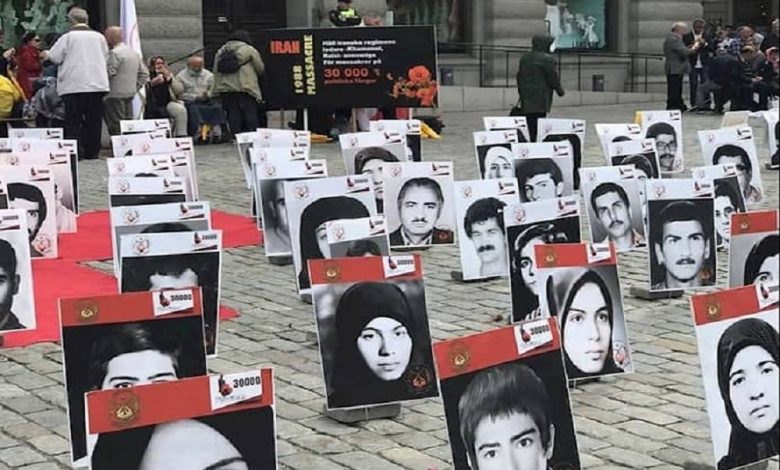The World Must Listen Survivors of Iran’s 1988 Massacre

Iran-1988-massacre
Written by
Amir Taghati
In 1988, the Iranian regime executed at least 30,000 political prisoners over the course of about three months. The current mullahs’ president, Ebrahim Raisi, was a leading perpetrator of that massacre, having served with three other officials on the Tehran “death commission” that oversaw the interrogation and sentencing of dissidents and activists, most of whom were members of the People’s Mojahedin Organization of Iran.
The statistics regarding the 1988 massacre are shocking enough. But the severity of that crime against humanity is made even clearer by eyewitness testimony which describes the ways in which Raisi and other officials mechanically worked through a list of potential victims, passing death sentences after trials lasting as little as one minute, then sending the condemned prisoners off to die in groups of six or more.
The 1988 Massacre of Political Prisoners in Iran: Eyewitness Accounts, Mahmoud Royaei
Sixteen such testimonials were recently posted to the website of the National Council of Resistance of Iran.
The video statements and accompanying transcripts were produced as part of a new phase in that campaign which emerged in the wake of the sham presidential election which brought Raisi to power on June 18.
There have many calls for inquiry into the massacre and set the stage for prosecution of leading perpetrators at the International Criminal Court. Various legislative committees in Europe and the Americas have accordingly passed resolutions condemning Tehran’s worst crime against humanity and affirming support for the opposition movement that is working to expose it. But unfortunately, such developments have translated into very little official action by entire Western governments.
Far from holding Raisi accountable for mass murder and the violent suppression of dissent, some Western governments even went so far as to send delegations to welcome his administration and provide it with legitimacy on the world stage despite being denied that same consideration at home.
Less than ten percent of Iran’s eligible voters participated in the June 18 sham election, following weeks of calls for a boycott. Although regime authorities deny this account of the boycott’s scale, they acknowledge that the majority of Iranians did sit out the election.
The regime’s supreme leader Ali Khamenei tapped Raisi as the next president after having previously appointed him to head the judiciary from early 2019 onward. This appointment ultimately served to preempt any doubt that might have existed regarding the reason for Khamenei’s decision to promote Raisi to the nation’s second-highest office. As judiciary chief, Raisi compounded his legacy of human rights abuses by overseeing key aspects of the nation’s worst crackdown on dissent in many years.
Who is Ebrahim Raisi, a candidate in Iran presidential election and an executioner in 1988 massacre
In November 2019, Iranians from all walks of life staged an anti-government uprising that spanned nearly 200 cities and towns. It was the second of its kind, having picked up the slogans like “death to the dictator” which defined nationwide protests in December 2017 and January 2018. That first uprising resulted in thousands of arrests and around 60 deaths, including several deaths by torture. But this paled in comparison to the regime’s response to the second uprising, which included mass shooting incidents that killed around 1,500 people in a matter of days. For months thereafter, Raisi’s judiciary carried out a campaign of systematic torture involving many of the 12,000 known and suspected activists who were arrested in the wake of the uprising.
These human rights abuses were promptly highlighted alongside the 1988 massacre when it became clear that Raisi was poised to ascend to the presidency. But the Iranian people certainly understood that Khamenei announced his support for Raisi not in spite of his attacks on the civilian population but specifically because those signified his readiness to confront a MEK-led opposition movement on an even larger scale in the future.
If such it occurs, Western governments will bear responsibility for providing the Raisi administration and the regime as a whole with reasons to believe that their impunity remains intact.
Iran Protests: Nationwide Uprising in Iran- November 2019
Human rights defenders throughout the world should strive to make sure that government leaders and UN delegates are fully aware of both the scale of the killing in 1988 and also the severity of the trauma still being suffered by those who survived for long. No government or international body should be capable of hearing accounts of political prisoners watching their friends and colleagues being dragged away en masse and still turn a blind eye to the fact that one of the chief authors of that suffering is now representing Iran to the outside world.
No one who does turn a blind eye to that fact should continue to be taken seriously afterward as an advocate for democratic principles or universal human rights. As the Raisi era begins in earnest, the international community must finally be compelled to make a choice between friendly engagement with such human rights abuses or political support for their victims. As tensions between the Iranian regime and its people grow during this era, each major world power will have to choose one side or the other.

